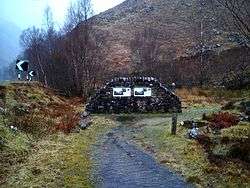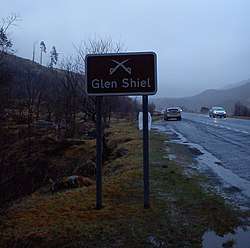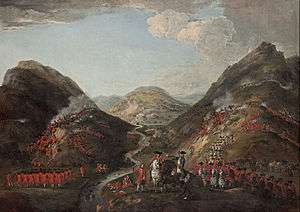Battle of Glen Shiel
The Battle of Glen Shiel (Scottish Gaelic: Blàr Ghleann Seile) was a battle in Glen Shiel, in the West Highlands of Scotland on 10 June 1719, between British Government troops (mostly Scots) and an alliance of Jacobites and Spanish, resulting in a victory for the Government forces. It was part of the Jacobite rising of 1719. It was the last close engagement of British and foreign troops in Great Britain. The Jacobite Scots were aiming to restore the exiled House of Stuart to the throne of the United Kingdom and were supported by Spanish soldiers as Spain was then at war with the United Kingdom of Great Britain. The battlefield has been included in the Inventory of Historic Battlefields in Scotland and is protected by Historic Scotland under the Historic Environment (Amendment) Act 2011.[4]
Background
Philip V, King of Spain and his Italian counsellor, Cardinal Giulio Alberoni, decided to meddle in the succession disputes, supporting the Jacobite claims and its Scottish Highland allies both to de-stabilise the Crown and set up a more pliant king (and Parliament) in its place.
The Jacobite George Keith, 10th Earl Marischal had left the Spanish port of Pasajes (Pasaia in Basque) and occupied the Isle of Lewis, including Stornoway where he set camp. On 13 April 1719, Keith's men disembarked on the Highlands near Lochalsh, although the Highlanders did not join the "Little Rising" in the expected numbers (the Spaniards carried 2000 guns to distribute), mistrusting the enterprise and waiting for news from the south. Keith could not proceed to Inverness and established his headquarters in the castle of Eilean Donan. The Spaniards were accompanied by William Mackenzie, 5th Earl of Seaforth (Scottish Gaelic: Uilleam Dubh Shìophort), who was chief of Clan Mackenzie, the Earl Marischal, and some Irish officers. They were joined by several hundred Highlanders, including members of Clan Mackenzie, Clan MacRae, Robert Roy MacGregor, and a party of other MacGregors. Some days later, the main body of the troop went south to stir up the Highlanders, leaving a small garrison (40-50 men) at the castle. The Jacobite forces were to be led by the Earl of Seaforth and also John Cameron of Lochiel, 18th Captain and Chief of Clan Cameron, along with Lord George Murray. Their plan of action was to capture Inverness.
Capture and destruction of Eilean Donan Castle
At the beginning of May, the Royal Navy sent five ships to the area for reconnaissance: two patrolling off Skye and three around Lochalsh, adjacent to Loch Duich. Early in the morning on Sunday 10 May, three of these ships anchored off Eilean Donan on the north side of Loch Duich, where the Spanish forces had established a base in Eilean Donan Castle, one of Mackenzie of Seaforth's residences. In the evening, under the cover of an intense cannonade, the ships' boats went ashore and captured the castle against little resistance. The Spanish prisoners were put on board HMS Flamborough and taken away to Edinburgh.[5] [6]
Lead up to battle
The Jacobite army had advanced about 12 miles from Eilean Donan, as far as the narrows of Glen Shiel where a mountain spur almost blocks the valley. The great natural strength of the Jacobite position had been increased by hasty fortifications. A barricade had been constructed across the road, and along the face of the hill on the north side of the river entrenchments had been thrown up. Here the main body was posted, consisting of:[7]
- 300 men of the Regiment Galicia from Spain, under its Colonel, Don Nicolás de Castro Bolaño, along with Brigadier Mackintosh of Borlum.
- 150 men of the Clan Cameron, under their chief Cameron of Lochiel.
- 150 men of Lidcoat's and 20 volunteers.
- 40 men of Clan MacGregor, under Rob Roy MacGregor.
- 50 men of Clan Mackinnon.
- 200 men of Clan Mackenzie, under their William Mackenzie, 5th Earl of Seaforth, on the extreme left, up on the side of Scour Ouran, along with a rebel Brigadier Campbell.
- 200 men of Clan Mackenzie, under Sir John Mackenzie of Coul.
- 150 men of Clan Murray, under William Murray, Marquess of Tullibardine and his younger brother, Lord George Murray, positioned on the hill on the south bank of the river.
- Men of the Clan Keith, under their chief, George Keith, 10th Earl Marischal.
The Government army's right wing was commanded by Colonel Clayton and composed of:
- 150 grenadiers under Major Milburn; Montagu's Regiment, commanded by Lieutenant Colonel Lawrence.
- 50 men under Colonel Harrison.
- Huffel's Dutch Regiment.
- Three Independent Highland Companies from the Clan Fraser of Lovat, Clan Ross and Clan Sutherland
- 80 men of the Clan Mackay, under their chief Ensign Mackay, Lord Strathnaver, on the flank.
The Government army's left wing, which was deployed on the south side of the river, consisted of:
- Clayton's Regiment, commanded by Lieutenant Colonel Reading.
- 100 men of the Independent Highland Company from the Clan Munro, under George Munro, 1st of Culcairn.
- The Government dragoons and the four mortars remained on the road
Battle of Glen Shiel
The Jacobites gathered for a last action, with a total of just over 1,000 troops.
On 5 June, British Government forces composed of both English and Scottish soldiers under General Joseph Wightman came from Inverness to block their march. They consisted of 850 infantry, 120 dragoons and 4 mortars. A detailed plan of the battlefield and the movements of the opposing forces was drawn up soon after the battle by John Henry Bastide, a subaltern in Montague's regiment who subsequently had a long career as a military engineer. They confronted the Jacobites at Glen Shiel, just a few miles from Loch Duich, on 10 June, near the Five Sisters hills. The Galician regiment occupied the top and the front of one of the hills, to their advantage, while the Jacobite Scots manned barricades on the sides.
The engagement began between about five and six o'clock when the left wing of the British Government army advanced against Lord George Murray's position on the south side of the river. The position was first shelled by the mortars and then attacked by four platoons of Clayton's regiment and Munro's. After some initial stubborn resistance, Lord George Murray's unsupported men were driven from their position and forced to retreat.
Once the Jacobite right wing had been dislodged, Wightman ordered his right wing to attack the Jacobite left.
The detachment, commanded by Lord Seaforth, was strongly positioned behind a group of rocks on the hillside. It was against them that Harrison's and Montigue's regiments were directed. Seaforth was reinforced by his own men under Sir John MacKenzie. Hard pressed, Seaforth sent for further reinforcements. Another group of men, under Rob Roy, went to his aid, but before it could reach him, his men gave way, and Seaforth himself was badly wounded.
Wightman concentrated his troops on the flanks, while the mortars battered the whole and pinned the Spaniards in their positions. Wightman's whole force was now directed toward the Jacobite centre.
The Spanish regulars stood their ground well, but found that most of their allies had deserted them, so they too retreated up the hill. Other clans followed and left their allies retreating uphill.
Historian Peter Simpson states that the Munro company ably led by George Munro of Culcairn took a very positive part in the fighting and that their bold action helped in the defeat of the Jacobites under the Earl Marischall.[8] Simpson also states that the battle raged for three hours but the superior power of the Government grenadiers along with the aggressive forays of the Munro Independent Company won the day for the Government.[9] At 9 o'clock in the evening, the Spanish surrendered, three hours after the start of the combat, while the remaining Jacobites fled into the fog, to escape execution as traitors.
The Jacobites were poorly provisioned and armed, and when the expected Jacobite support from the Lowlanders was minimal, spirits fell completely. The Rising was abandoned and the Jacobites dispersed to their homes.
The mountain in Glen Shiel on which the battle took place is called Sgurr na Ciste Duibhe, it has a subsidiary peak which was named Sgurr nan Spainteach (The Peak of the Spaniards) in honour of the Spanish forces who fought admirably in the battle.[10]
Aftermath
Two of the Jacobite commanders, Lord George Murray, William Mackenzie, 5th Earl of Seaforth, were badly wounded. Robert Roy MacGregor is claimed in many accounts to have been wounded, but the actual text of Ormonde's account of the battle in the "Jacobite Attempt of 1719"[11] has the following – "... Finding himself hard-pressed, Lord Seaforth sent for further support. A reinforcement under Rob Roy went to his aid, but before it reached him the greater part of his men had given way, and he himself had been severely wounded in the arm." Note that this does not state that Rob Roy was wounded, but Seaforth. John Cameron of Lochiel, however, after hiding for a time in the Highlands, made his way back into exile in France.[10] George Keith, chief of Clan Keith and the last Earl Marischal, fled into exile in Prussia, where his brother Francis Keith wrote a narration of the battle. In spite of a later pardon, Keith never returned to Scotland and became the Prussian ambassador to France and later to Spain. The 274 Spanish prisoners were reunited with their comrades in Edinburgh and by October, negotiations allowed their return to Spain.[3]
On the British Government side, casualties were lighter; George Munro of Culcairn was wounded in the legs by musket shot, but survived. A Government expedition under Lord Cobham was launched against the coast of Spain in October 1719 which succeeded in capturing Vigo.
 Battle of Glen Shiel Memorial, Glen Shiel
Battle of Glen Shiel Memorial, Glen Shiel Road sign, Glen Shiel 2015
Road sign, Glen Shiel 2015
References
- ↑ Glenshiel canmore.org.uk. retrieved January 14, 2017.
- ↑ Spiers, Crang & Strickland p. 358
- 1 2 1719 – Battle Of Glen Shiel scotclans.com. Retrieved January 14, 2017.
- ↑ "Inventory battlefields". Historic Scotland. Retrieved 2012-04-12.
- ↑ Excerpts from the official logs of HMS Worcester and HMS Flamborough - /log_01.htm Lt Randolph Barker, HMS Flamborough clan-macrae.org.uk. Retrieved January 14, 2017.
- ↑ The Battle of Glenshiel - June 10, 1719 clan-cameron.org. Retrieved January 14, 2017.
- ↑ Coull, Sam (2000). Nothing But My Sword: The Life of Field Marshal James Francis Edward Keith. Birlinn. p. 76. ISBN 9781841580241.
- ↑ Simpson, Peter. (1996). The Independent Highland Companies, 1603–1760. p. 155. ISBN 0-85976-432-X.
- ↑ Simpson, Peter. (1996). The Independent Highland Companies, 1603–1760. p. 103. ISBN 0-85976-432-X.
- 1 2 The Battle of Glenshiel - June 10, 1719 www.clan-cameron.org. Retrieved January 14, 2017.
- ↑ The Jacobite Attempt of 1719, ed by WK Dickson, SHS 1895, Introduction li and Page 272
- Misión en Escocia (pp. 68–74), Muy Interesante 288, May 2005, Abraham Alonso.
- A History of Scotland, J. D. Mackie, p. 273, ISBN 0-14-013649-5
- The Jacobite Attempt of 1719, William K. Dickson (1895)
- Spiers, Crang & Strickland, Edward M., Jeremy A., Matthew. A Military History of Scotland. Edinburgh University Press Series (2012). ISBN 9780748633357.
External links
| Wikimedia Commons has media related to Battle of Glen Shiel. |
- Digitised copy of the "A Plan of the Field of Battle that was fought on ye 10th of June 1719, at the Pass of Glenshiels in Kintail North Britain" drawn by John Henri Bastide in 1719 from National Library of Scotland
- Battle of Glen Shiel@Historynet.com


.svg.png)